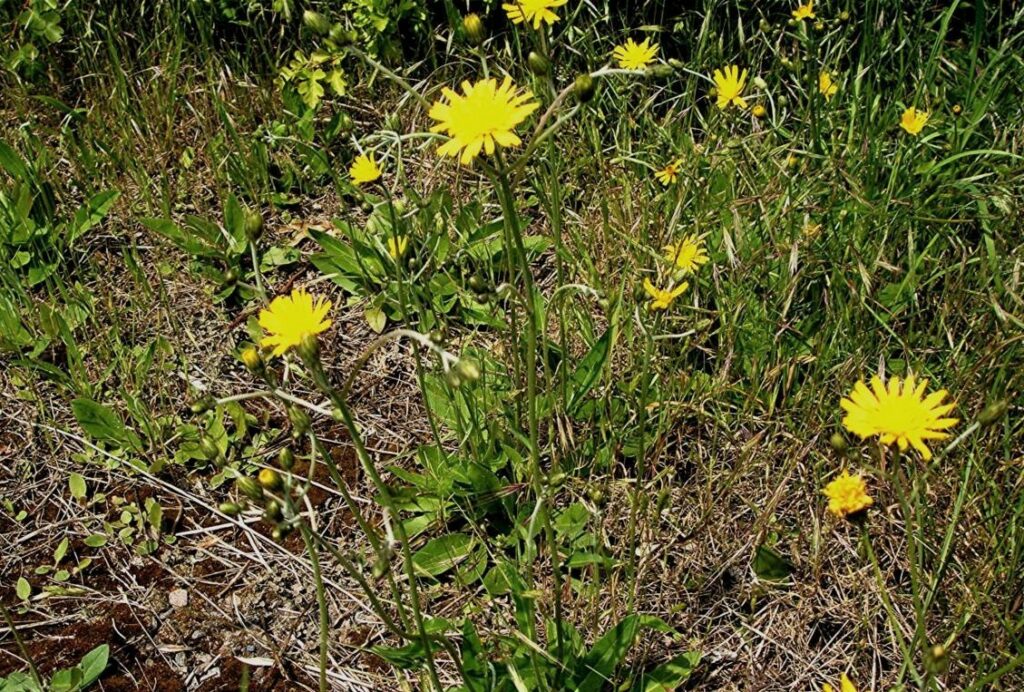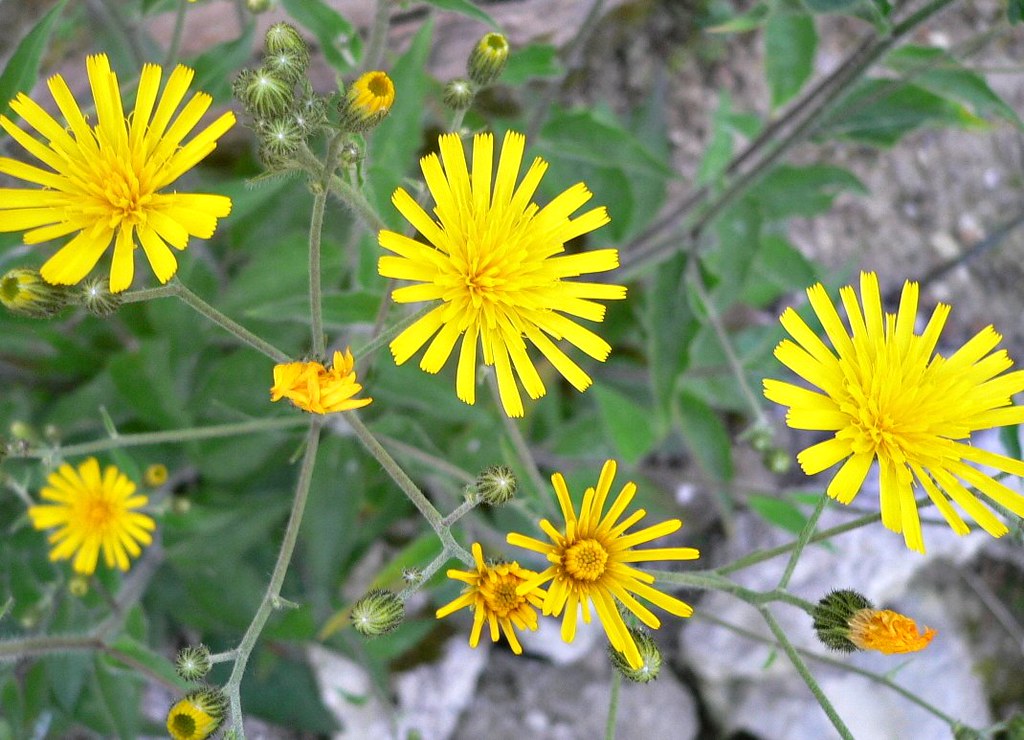Hawkweed (Hieracium), a genus of flowering plants, is one of the world’s most prolific and important species today. With over 4,000 unique species found in temperate regions around the globe, it’s no wonder that hawkweed has been studied extensively by botanists and biologists alike. This article will explore some of the most interesting facts about this fascinating plant.
Characteristics Of Hawkweed
The first thing to know about hawkweed is that it’s a perennial herbaceous plant which typically grows in grasslands or meadows. Its flowers are usually yellow or white, and its leaves are typically divided into narrow segments, giving them a feathery look. Hawkweed also has an extensive root system that helps hold soil together, preventing erosion. As such, it plays a vital role in maintaining healthy ecosystems.
Hawkweed is like a jack-in-the-box, popping up in unexpected places. It is native to Europe, but has naturalized across much of North America and can grow in meadows, fields, roadsides, and open woods.
It has a deep taproot which helps it survive through the winter months when temperatures drop, and other plants die off. Its flowers are edible and have a mild flavour. The plant also contains several compounds which have anti-inflammatory properties.
Although hawkweed can be beneficial as a food source or for medicinal purposes, it can become invasive if left unchecked. It spreads quickly using its seeds and root pieces, so keeping an eye on any hawkweed growth in your area is important.

Types Of Hawkweed
Now that we know the essential characteristics of hawkweed let’s look at the different types. Hawkweeds belong to the Hieracium genus, which includes hundreds of species. The flower heads are usually yellow and sometimes have purple-tipped ray florets. Each species has distinctive characteristics that can help you identify it.
A common type of hawkweed is Hieracium umbellatum, also known as king devil or mouse-ear hawkweed. It has yellow flowers with long, thin petals and grows around four inches tall in clumps. It is native to Europe but can also be found growing throughout the United States and Canada.
Another type of hawkweed is Hieracium caespitosum, commonly known as field hawkweed. It is a perennial herb with bright yellow flowers and grows up to two feet tall. It prefers open meadows and grasslands where it can get plenty of sunlight.

Natural Habitat And Distribution
Hawkweed has a vast natural habitat and distribution range throughout North America, Europe, and Asia.
- Hawkweed grows in moist meadows and grassy regions
- It grows in sunny areas such as roadsides and open woods
- It also thrives in shaded areas such as pastures and clearings
- In Europe, it is primarily found in the alpine regions of France, Italy, Germany, Austria and Switzerland
- In the US, it can be found on the east coast from Maine to Florida and westward to California
Hawkweed prefers soil rich in nitrogen and calcium with consistent moisture levels. Its ability to thrive in various conditions makes hawkweed one of the most prolific species of plants on Earth. Its invasive nature makes it difficult to eradicate once it takes hold of an area. Its presence can have a detrimental effect on local ecosystems due to its aggressive growth habit. For these reasons, many countries have stringent laws regarding cultivation or removal.
In summary, hawkweed has a vast natural habitat and distribution throughout North America, Europe, and Asia. It prefers soil rich in nitrogen and calcium with consistent moisture levels; however, it can withstand various climactic conditions. Additionally, its invasive nature has led to numerous laws concerning the cultivation or removal of this plant species, making it essential for gardeners and conservationists alike to be aware of its presence.
Impact On Flora And Fauna
The introduction of hawkweed (hieracium) has had detrimental effects on flora and fauna in its new environment. It is a non-native, invasive species that can survive and reproduce quickly, thus outcompeting native species. Hawkweed is particularly problematic for native plant species, as it often takes over their habitat and resources. This makes it difficult for local plants to maintain their populations and survive.
Hawkweed also affects the fauna in an area. The presence of this species can cause a decrease in food availability for certain animals, either directly or indirectly. For example, hawkweed may take up all the available resources needed by other plants that are a food source for animals. This leads to a decrease in food sources for the native wildlife in an area, which can have long-term consequences on their populations.

Hawkweed As a Food Source
Hawkweed is used as a food source for butterflies, bees and other pollinators due to its nectar-rich flowers. It also provides habitats for small animals and fungi, making it an essential part of many ecosystems worldwide.
Uses In Traditional Medicine
Hawkweed has been used for centuries in traditional medicine. Its leaves, stems, and roots have been used for various ailments, including skin inflammation and fever. In some cultures, the leaves are boiled and applied to areas affected by cuts or wounds to promote healing. The stems are also boiled, and its extract is applied topically to relieve pain from rheumatism and arthritis.
The root of hawkweed has long been known as an expectorant and diuretic, useful for treating chest congestion and urinary tract infections. It can be dried and ground into a powder or made into a tea infusion to treat those conditions. In addition, the root has been used as an appetite stimulant and digestive aid, helping with bowel regularity and bloating issues.
Hawkweed has become increasingly popular in recent years due to its potential health benefits, anti-inflammatory properties and antioxidant activity. Research is being conducted on how it may be beneficial in treating certain cancers or other serious illnesses. Studies have also suggested that it could be effective against diabetes or high blood pressure.
Common Problems And Pests Related To Hawkweed
Hawkweed is a resilient plant that can suffer from specific problems and pests. One of these is powdery mildew, caused by a fungus that coats the plant leaves with white powder. This may cause the leaves to turn yellow or brown and wilt, potentially leading to death in extreme cases. To prevent this problem, it’s important to water at ground level and avoid overhead irrigation. Other issues include slugs and snails, which eat away at the foliage, and aphids which attack younger growths.
Gardeners can use insecticides such as pyrethrin or insecticidal soap to combat these pests. It’s also important to remove any affected leaves eaten by slugs or snails and any dead foliage that could harbour fungal spores. In addition, it’s best to keep the bed free of debris and weeds that could attract pests.

How To Control The Spread Of Hawkweed
The spread of hawkweed can be daunting, but it is not impossible to control. Like wildfire, the weed must be extinguished with the right tools. This invasive species can be kept at bay with careful attention and timely action.
To begin controlling the spread of hawkweed, one should first identify where it is growing and understand how it propagates. Knowing how it spreads can help in understanding what methods are needed to contain its growth. For example, hand-pulling or mowing can be used for small infestations; however, these methods may only provide temporary relief since hawkweed can reproduce rapidly from even small fragments left behind.
Chemical herbicides such as glyphosate can also be used to target hawkweed. When applied correctly according to directions on the product label, herbicides are an effective way to control the weed’s growth. However, environmental risks may be associated with using chemical products, so all potential impacts should be considered before taking action. Additionally, chemical treatment should always follow integrated pest management (IPM) principles that focus on prevention and long-term solutions that protect people and wildlife from harm.
Therefore, controlling hawkweed requires an integrated approach that combines physical removal methods with chemical treatments when necessary and appropriate. By taking prompt action and employing multiple strategies, it is possible to keep this invasive species in check before it takes over an entire area.
Potential Health Risks From Consuming Hawkweed
Hawkweed has been consumed as a food and folk medicine for centuries, but its potential health risks are largely unknown. The plant contains a range of alkaloid compounds, which can be toxic in high concentrations. Additionally, the leaves and roots contain furocoumarin glycosides, which can cause dermatitis if the skin is exposed to them. Therefore, it is essential to exercise caution when consuming hawkweed and avoid eating raw or unprocessed plant parts.
Studies have suggested that some alkaloids present in hawkweed might have anti-inflammatory properties and benefits for cardiovascular health. However, more research must be done before these effects can be confirmed. It is also worth noting that due to the presence of furocoumarin glycosides, overeating hawkweed may cause digestive problems such as nausea and vomiting.
For these reasons, it is advised that people limit their intake of hawkweed and always check with a qualified medical professional before consuming the plant for any purpose. Those who are pregnant or breastfeeding should avoid consuming hawkweed altogether as it could pose a risk to their baby’s health. Due to the lack of scientific evidence on its safety and potential toxicity, it is best to use caution when consuming this plant.
Conclusion
To conclude, hawkweed is a plant that has been around for centuries and has many uses. It can be found in many parts of the world and has positively and negatively impacted flora and fauna. While there may be potential medical uses for it, there are also potential health risks associated with consuming it. As such, caution should be exercised when dealing with the plant or its products.
I believe that while taking advantage of its medical properties may be beneficial in some cases, it is essential to take preventive measures against its spread not to disrupt local ecosystems or cause any harm to humans. Controlling its growth can help avoid any possible unwanted consequences and ensure that future generations can use it responsibly.
In short, hawkweed is a fascinating plant with many potential applications that must be studied carefully before adoption. With the right precautions and management strategies in place, it can provide numerous benefits without causing too much disruption to our environment or health.
Sam loves to learn about animals and their habitats. He has been a nature lover from a very young age, and has been writing papers and articles about wildlife for as long as he can remember.
